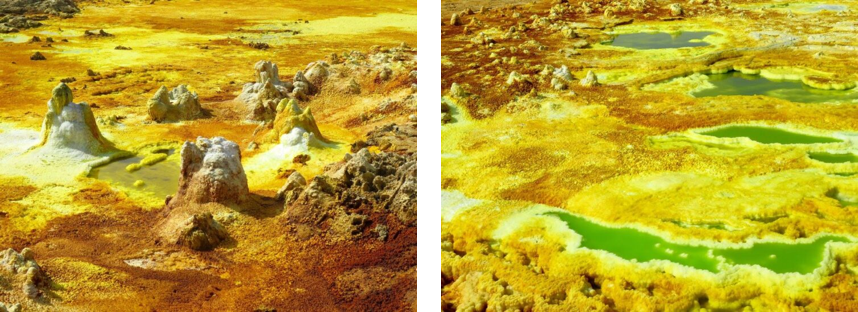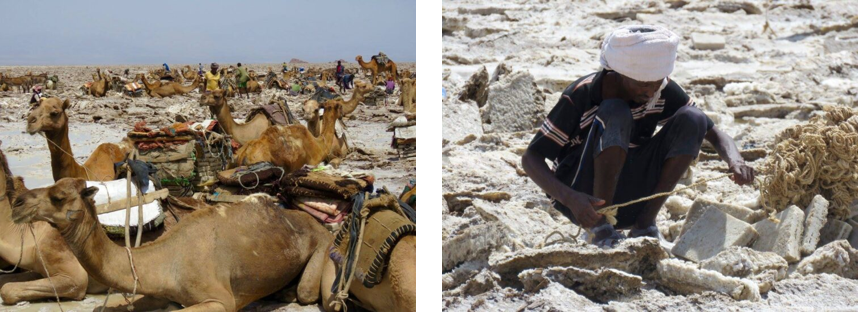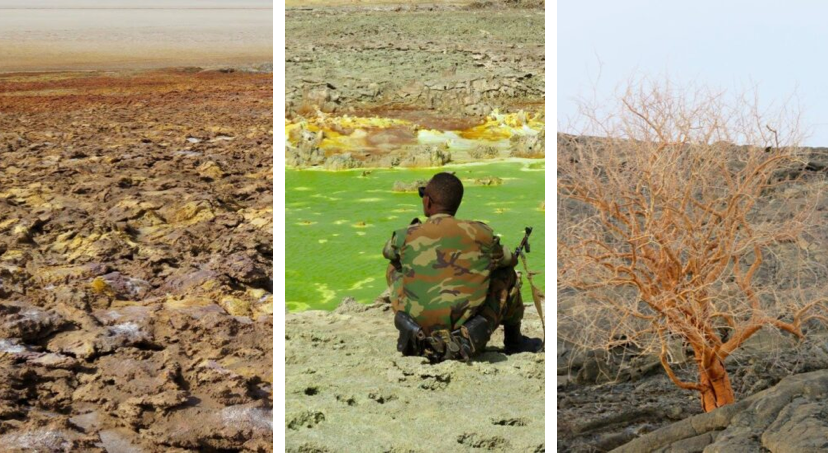Danakil Depression: Like No Place on Earth

Posted on Sat 7 Aug 2021 · by James Chisnall
With Elon Musk and SpaceX’s successful launch into space, commercial travel to space is closer than ever. However, it’s likely that it will remain an adventure reserved for those with plenty of cash to spare, so for the majority of us, a trip to Mars remains a very distant pipedream…. or does it? Having visited the Danakil Depression in Ethiopia it’s easy to argue that maybe you don’t have to even leave Earth to explore what truly feels and looks like another planet. Often referred to as one of the most alien places on Earth with British explorer Wilfred Thesiger even calling it a “land of death” such as its harsh and seemingly totally inhabitable environment.
“Bubbling volcanoes light up the night sky, sulphurous mounds of yellow contort into other-worldly shapes, and mirages of camels cross lakes of salt. Lying 100m and more below sea level, the Danakil Depression is about the hottest and most inhospitable place on earth. In fact, it’s so surreal that it doesn’t feel like part of earth at all. If you want genuine, raw adventure, few corners of the globe can match this overwhelming wilderness. But come prepared because with temperatures frequently saying hello to 50°C and appalling ‘roads’, visiting this region is more an expedition than a tour.” – Lonely Planet

The Danakil Depression is so other-worldly that scientists use it to study the possibility of life on other planets
The Danakil Depression is a vast plain in the northern part of the Afar Triangle in Ethiopia. It’s the meeting point of three tectonic plates and as a result of Africa and Asia moving apart, it causes rifting and subsequent volcanic activity. It’s this activity that causes the land to sink below sea level. It was 125m below on our last visit and this creates the colourful alien-like sulfurous hot springs, acid pools, steaming fissures, salt plains, and surrounding volcanoes. Add to this that the Danakil also records the highest average yearly temperature in the world at about 35 degrees Celsius – day and night. Considering all this, it’s not hard to see why Wilfred Thesiger described it as he did!

Lava lake in the Erta Ale volcano, one of only handful in the world
As incredibly inhospitable as the depression is, it has been home to the Afar people for centuries, a nomadic tribe who live a basic life moving around the Danakil with their small herds of cattle, goats, and camels. They primarily survive from mining salt, the region’s “white gold” which was even used as a form of currency before the 20th century. Unsurprisingly it’s a hard life. Miners travel for hours over huge distances in long camel caravans, often with over 100 camels, to collect salt from plains around Lake Afar. The salt is typically sold at the Mekele market which is around a week’s walk from the salt plains!

Mining salt is a major source of income for many Afar people. Camels wait to be loaded up with salt for the long journey.
The Danakil is also called the cradle of humanity after Donald Johanson discovered the famous fossil “Lucy” in 1974, which is believed to be 3.2 million years old. This discovery, along with other fossils found has lead many palaeontologists to suggest this could even be the location where the human species first evolved. Lucy, herself, is on display at the National Museum of Ethiopia in Addis Ababa, so it’s well worth a visit. Scientists visiting the Danakil aren’t only looking to the past but also to the future, as the extreme conditions the Danakil Depression are being investigated to help understand how life might arise on other planets. It seems most fitting that the Danakil Depression is a focal point in humanity’s past and possible future evolution when you see how the Afar people have adapted to survive in conditions regular people simply couldn’t bear.


A camel caravan, with salt mined by hand, travels across the salt plains in the short rainy season in the Danakil Depression.
This adventure certainly isn’t for everyone, it’s a tough few days where you have to forgo modern comforts and combat the draining oppressive heat but you are witness to a truly unique landscape you’re unlikely to see anywhere else. The Dallol sulfur fields, with their neon green and yellow fields, are simply breathtaking, the strength and adaptability of the Afar people humbling and the night spent sleeping by the region’s most active volcano, Erta Ale, is a truly once in a lifetime experience. So if you are looking for an intrepid, once in life-time adventure then the Danakil is really is the ultimate.
“Then we went to the Danakil and were blown away there. Dallol is like nothing we’ve seen before!” Joanne M.

My visit to Dallol Sulfur fields and Erta Ale.
If you are interested in visiting the Danakil Depression then we would be delighted to help you organise it for you, whether as a private tour or as part of our Extreme Ethiopia Experience run by our fabulous local manager Shigo.
Read more from our blog here
